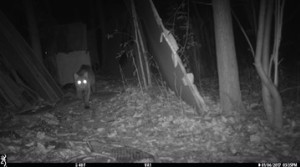2021. Purchase Campus Wildlife are Affected by Human Influence
December 13, 2021
Open gallery

Above is a trail camera photo of a bobcat, walking through the Sculpture Garden in the woods behind the Visual Arts building, on SUNY Purchase College campus.
Human encroachment into wild spaces alters wildlife diversity and abundance. Raccoons, squirrels, and white-tailed deer are thriving on the SUNY Purchase campus. Meanwhile, bobcats, coyotes and skunks skip out on a college education. #savespaceforwildlife #conserveandpreserve
by Kristen Pareti
SUNY Purchase College campus is quite beautiful, and it’s no surprise. Purchase is one of the leading liberal arts schools in our nation, with a strong reputation and emphasis in the arts. Each building is architecturally designed with a striking, modern flare. In between buildings are walkways thoughtfully designed and manicured with aesthetically pleasing plants and trees. Sculptures and murals are found throughout the campus grounds. Purchase itself is like a constant art exhibition. If you look at it that way.
While this general urbanization and re-managing of the landscape has given us a beautiful campus, we are subsequently altering the native ecosystems. There are still some sections of campus that have forests, but they are fragmented by roads and other man-made structures. A healthy ecosystem has many components, but a diverse food web to balance out Mother Nature is crucial. This means a variety of species are needed to maintain and preserve the environment.
In order to see how human presence is affecting wildlife species abundance, we set up trail cameras throughout campus. These cameras were located amongst wild ecosystems that have a human disturbance. What is “human disturbance” in an ecosystem, you ask? In our case, it’s the Sculpture Garden in the woods behind the VA building, the firepit in Alumni Woods, and the trails over by the Athletic Fields. These environments have been influenced and altered by humans but are still habitats and land that wildlife uses. Our findings recorded 15 different wildlife species amongst these three locations. The most abundant and widely distributed species were raccoons, squirrels, and white-tailed deer. The least common were bobcats, coyotes, and skunks.
As human development continues wild ecosystems dwindle. It is important to understand how this affects wildlife species in order to preserve healthy populations and overall healthy ecosystems. Even now, development on campus continues as construction for a senior living center begins. Where healthy forest used to greet you on your drive in and out of campus is now a section of clear-cut empty land. A mountain high pile of upended trees and vegetation remains like a gravestone to the lost habitat and resources for wildlife that once lived there. With data providing evidence to which species struggle in human influenced environments we can aim to enforce protection through policy by providing them means of habitat, resource or protected land.